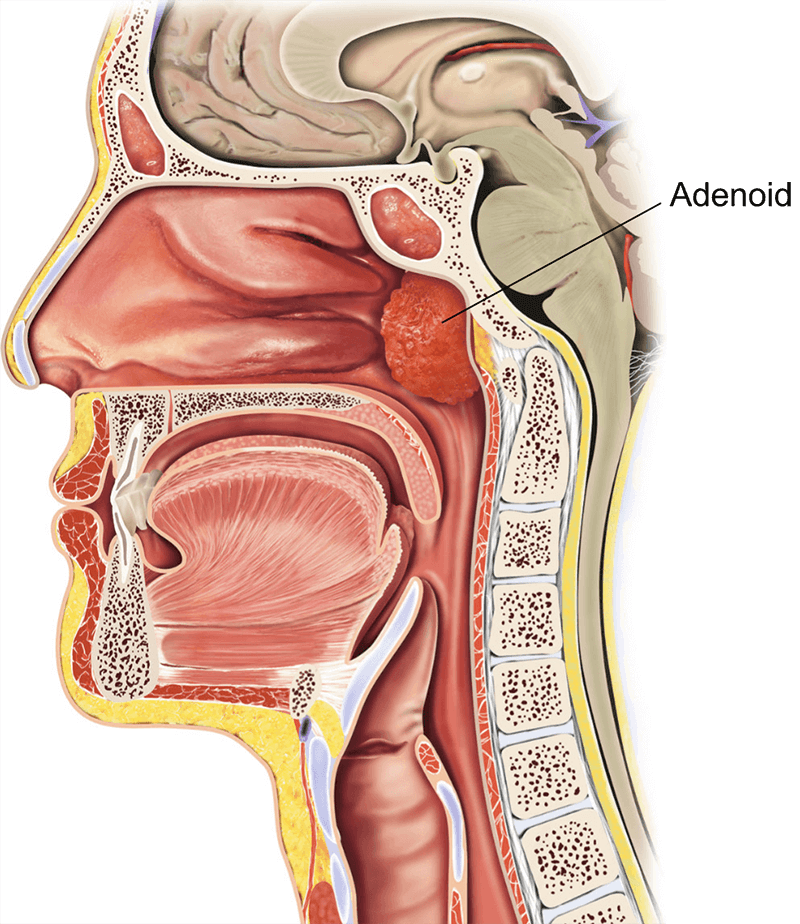This page will give you information about an adeno-tonsillectomy. If you have any questions, you should ask your GP or other relevant health professional.
What are the adenoids and tonsils?
The adenoids and tonsils are part of a group of lymphoid tissues (like the glands in the neck) that help to fight off infection. The adenoids and tonsils enlarge naturally in children at around the age of 3 and usually shrink away again by the age of 7. The enlargement happens because children are exposed to a lot of new infections at this age and have many colds.
What are the benefits of surgery?
Your child should get relief from a blocked or runny nose, and may get a better quality of sleep.

If your child’s adenoids are large, removing them will allow air to pass through your child’s nose while they are talking and eating. This may improve the quality of your child’s voice.
Tonsillitis happens if the tonsils become infected. This causes pain, fever and difficulty swallowing and can make your child feel unwell.
Are there any alternatives to surgery?
Your doctor may be able to give you steroid nasal sprays to improve your child’s symptoms of a blocked nose and reduce the size of the adenoids.
There are no other treatments for enlarged adenoids other than to leave them alone and wait for the problem to get better.
Surgery is the only dependable way to stop tonsillitis that keeps on coming back.
What does the operation involve?
The operation is performed under a general anaesthetic and usually takes about 30 minutes.
Your surgeon will remove the adenoids through your child’s mouth.
Your surgeon will perform the tonsillectomy through your child’s mouth using one of the following techniques.
- Cold dissection technique – Your surgeon will use a steel instrument to peel or cut the tonsil away from the layer of muscle underneath it.
- Diathermy technique – Your surgeon will use a special instrument that uses heat to stop the bleeding.
- Coblation technique – Your surgeon will use an instrument that uses radio-frequency energy to dissolve the tonsil.
What can I do to prepare my child for the operation?
Your child should try to maintain a healthy weight. They will have a higher risk of developing complications if they are overweight. If your child is having surgery to improve their breathing during sleep, it is less likely to be successful.
What complications can happen?
General complications of any operation
- bleeding
- infection of the surgical site (wound)
- allergic reaction to the equipment, materials or medication
Specific complications of this operation
- adenoid tissue regrowing
- small pieces of the tonsil may be left behind
- lingual tonsillitis
- Earache
- Stiff jaw
Consequences of this procedure
- pain
How soon will my child recover?
They should be able to go home the same day or the day after.
It is important your child eats normal food that needs to be chewed and swallowed. This keeps the muscles at the back of the throat moving.
Your child will need to stay off school and away from groups of people for 2 weeks. This is to help prevent throat infections while your child’s throat is still healing.
Most children make a full recovery and return to normal activities.
Summary
For those children who have a very blocked nose or disturbed sleep, an operation should give them a better quality of life. Surgery is the only dependable way to stop tonsillitis that keeps on coming back and the resulting pain, fever and difficulty swallowing.


